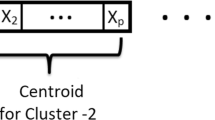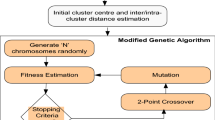Abstract
This paper deals with the clustering problem, where an order of elements plays a pivotal role. This formulation is very usable for wide range of Decision Support System (DSS) applications. The proposed clustering method consists of two stages. The first is a stage of data matrix reorganization, using a specialized evolutionary algorithm. The second stage is a final clustering step and is performed using a simple clustering method.
Research partly supported by the grant from the State Committee for Scientific Research. Decision no. 55/E-82/SPB/5.PR UE/DZ 385/2003–2005 of 16.07.2003
Access this chapter
Tax calculation will be finalised at checkout
Purchases are for personal use only
Preview
Unable to display preview. Download preview PDF.
Similar content being viewed by others
References
Altus S S, Kroo I M, Gage P J (1996) “A Genetic Algorithm for Scheduling and Decomposition of Multidisciplinary Design Problems”, Journal of Mechanical Design, Vol. 118, No. 4, 486–489
Browning T R (2001) “Applying the Design Structure Matrix to System Decomposition and Integration Problems: A Review and New Directions”, IEEE Transactions on Engineering Management, Vol. 48, No 3
Lenkstra J K (1977) “Sequencing by Enumerative Methods”, Matematisch Centrum, Amsterdam
McCormick W T, Schweitzer P J, White T W “Problem decomposition and data reorganization by a clustering technique”, Operations Res. 20, 1972, 993–1009
McCulley C, Bloebaum C (1996) A Genetic Tool for Optimal Design Sequencing in Complex Engineering Systems, Structural Optimization, Vol. 12, No. 2–3, 186–201
Mulawka J, Stańczak J (1999) “Genetic Algorithms with Adaptive Probabilities of Operators Selection”, Proceedings of ICCIMA’99, New Delhi, India, pp. 464–468.
Potrzebowski H, Stańczak J, Sęp K (2004) “Evolutionary method in grouping of units with argument reduction”, ICSS, Wrocław
Rogers J L (1997) “Reducing Design Cycle Time and Cost Thorough Process Resequencing”, International Conference on Engineering Design ICED 997, Tampere, Finland
Stańczak J (1999) “Rozwój koncepcji i algorytmów dla samodoskonalących się systemów ewolucyjnych”, Ph.D. Dissertation, Politechnika Warszawska
Sysło M M, Deo N, Kowalik J S (1983) “Algorithms of discrete optimization”, Prentice-Hall
Yu T L, Goldberg D E, Yassine A, Yassine C (2003) “A Genetic Algorithm Design Inspired by Organizational Theory”, Genetic and Evolutionary Computation Conference (GECCO) 2003, Chicago, Illinois, USA, Publ. Springer-Verlag, Heidelberg, Lecture Notes in Computer Science, Vol 2724/2003, 1620–1621.
Author information
Authors and Affiliations
Editor information
Editors and Affiliations
Rights and permissions
Copyright information
© 2005 Springer-Verlag Berlin Heidelberg
About this paper
Cite this paper
Potrzebowski, H., Stańczak, J., Sęp, K. (2005). Evolutionary Method in Grouping of Units. In: Kurzyński, M., Puchała, E., Woźniak, M., żołnierek, A. (eds) Computer Recognition Systems. Advances in Soft Computing, vol 30. Springer, Berlin, Heidelberg. https://doi.org/10.1007/3-540-32390-2_32
Download citation
DOI: https://doi.org/10.1007/3-540-32390-2_32
Publisher Name: Springer, Berlin, Heidelberg
Print ISBN: 978-3-540-25054-8
Online ISBN: 978-3-540-32390-7
eBook Packages: EngineeringEngineering (R0)




